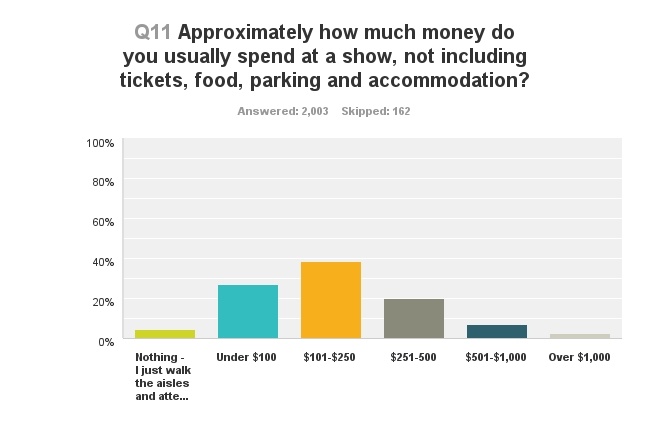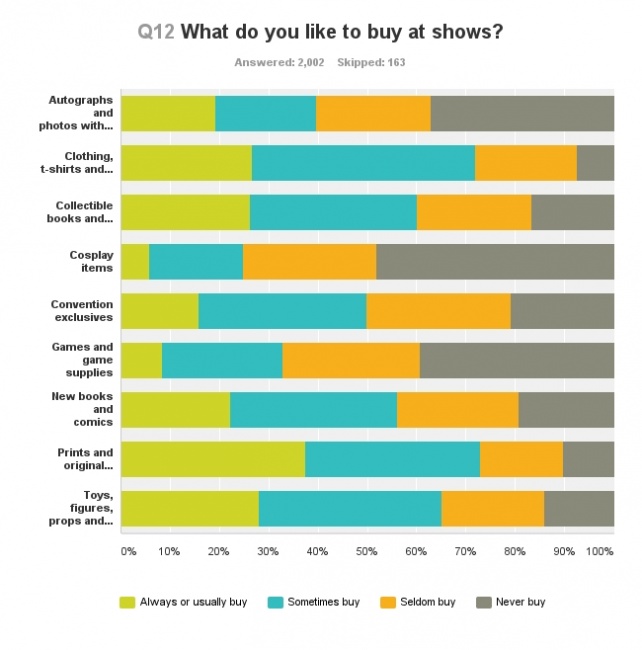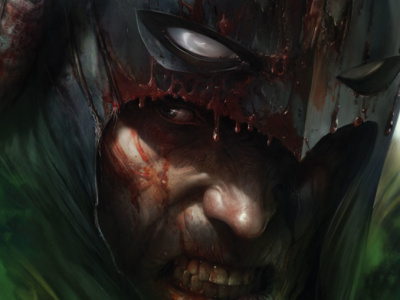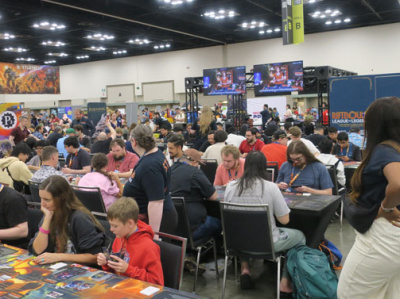The 2015 Eventbrite survey follows a similar study done last year, but fills in a few gaps. This year’s poll of 21 questions was fielded for three weeks in May, 2015 and received over 2100 responses from fans in 48 US states and territories, plus 4% from overseas. The sample includes a broad representation across age, income and geography as well as fan interests and intensity.
Full disclosure: I worked closely with Eventbrite to develop, deploy and analyze the survey data.
Click any image for larger view.
Fandom has achieved gender parity. The 2014 survey found a 54-46% male/female split across all fandoms, but 50/50 under age 30, which was big news at the time.This year, using the same methodology and comparable sample size, the result was parity across the board: 48.9% female, 48.7% male, and 3.1% non-binary/other (an option added for the 2015 survey).
However, because the survey asked respondents to identify their primary fan interest (alt/small-press, anime/mange, comic books and graphic novels, comic/genre-based media, tabletop/RPG, science fiction/fantasy, videogaming, or fans of a single pop culture property), the other demographic fact that jumped out is that no single category of fandom is close to 50/50. Comics, toys and gaming are predominantly male, while media, anime/manga and sci-fi/fantasy fandom are predominantly female.
Following the money. The survey also polled on spending at conventions. Most fans spend between $100-$500 at shows over and above tickets, parking, lodging and food. Comic fans tend to be the biggest spenders; alt and small press fans the lightest.By far the most popular purchase at conventions across just about every demographic cut is prints and original art. 37% of all respondents said they “always or usually” buy art at shows, and an additional 35% say they sometimes buy it. Comic fans are the biggest buyers at 48% “always,” but even videogame fans always or usually buy art 30% of the time.
Other popular purchases include clothing, t-shirts, and non-cosplay fashions (27% always/usually buy, 45% sometimes buy), toys and collectible merchandise (28% always/usually, 37% sometimes) and collectible books and comics (26% always/usually, 34% sometimes).
The least popular purchases across the board? Cosplay items (48% never buy), autographs and photos with celebrity guests (19% always/usually buy, 37% never buy) and convention exclusives (16% always/usually buy, 50% seldom or never buy).
Some more spending data by fandom subgroup:- Comic and genre-based movie fans are most likely to “always/usually” or “sometimes” buy autographs and photos with celebrity guests. Gamers, anime/manga fans and especially alternative/small press fans are least interested, with huge majorities reporting they “never” buy these.
- Comic and genre-based media fans are also most likely to buy clothing, t-shirts and fashion accessories, although most fans report buying these at least sometimes.
- Who buys collectible comics? Comic collectors (56% always/usually, another 29% sometimes). Videogamers are least interested.
- Very few people (even including cosplayers) buy cosplay items at conventions. Anime/manga fans exhibited the strongest interest, with 18% saying they always/usually buy them. Sci-fi/fantasy fans were a distant second at 5%. Majorities of alternative/small press, comic book and gaming fans never buy these items at conventions or shows.
- 29% of toy fans say they always or usually buy convention exclusives. No other fan subgroup breaks 20% on saying these are must-buy items.
Cosplayers: intense fans, big spenders. Overall, 55% of survey respondents cosplay at events at least once in a while, with more than 23% identifying as serious cosplayers. According to the numbers, cosplayers are likely to be female (nearly 64%), between ages 23-39 (60%), and fans of either anime/manga (29%), comics and genre-based media (21%) or science fiction/fantasy (18%). They also enjoy videogaming (60%) and comics (58%) a lot. Nearly 60% describe themselves as super-fans, and a whopping 28% have been to five or more fan events in the past 12 months. They are by far the most intense segment of fandom by most measures on the survey.
But do they spend money? Yes, serious cosplayers spend at the same levels as other fan demographics, despite having lower household incomes than the average fan. 61% spend between $100 and $500 at shows; 8% spend over $500. Their favorite purchases are prints and original art (44% always/usually, 34% sometimes), toys and collectibles, and clothing and non-cosplay fashion items, all at roughly the percentages as other fan subgroups.
What cons are doing right and wrong. The survey also polled on attendees’ attitudes about their event experiences on a number of levels.
Given a choice between “fan events with a single focus (comics, games, sci-fi, Star Trek, Doctor Who, etc.)” and “fan events that cover the whole pop culture spectrum,” fans prefer more general pop culture shows by a margin of more than 2-1.
42% of fans surveyed say that shows between 10,000-50,000 are just right. 37% prefer smaller than 10,000, 20% prefer bigger shows.
Generally speaking, fans give conventions high marks for convenience of obtaining tickets online, including VIP and specialty items; and passing grades on badge pickup procedures and the ability to book travel and accommodation through the Con site.
Fewer than 20% of respondents ranked their convention’s mobile app as “great” with 16% calling it unsatisfactory. But by far the biggest complaint among all con-goers is connectivity and wi-fi at the event. Only 12% rated this as great with 30% calling it “satisfactory,” compared to 40% calling it “unsatisfactory.”
When asked, “in general, do you feel that the fan events you attend do enough to make all attendees feel safe and welcome,” 93% answered yes, 7% answered no.
More data, better shows. The team at Eventbrite conducted this survey to get more insight into the fan convention market, which continues to grow at a torrid pace. Over the summer, the company will release a white paper with ideas for event organizers and exhibitors based on the data trends revealed in this survey.
I’ll also be discussing this and other fandom data at San Diego Comic-Con at a panel called “The Future of Fan Culture,” Sunday afternoon at 3:30, along with journalist Heidi MacDonald and data analyst/blogger Brett Schenker, moderated by Michael Cavna of the Washington Post.
Check out the gallery below for more charts and infographics.
--Rob Salkowitz (@robsalk) is the author of Comic-Con and the Business of Pop Culture.
The opinions expressed in this column are solely those of the writer, and do not necessarily reflect the views of the editorial staff of ICv2.com.








 View Gallery: 8 Images
View Gallery: 8 Images 



